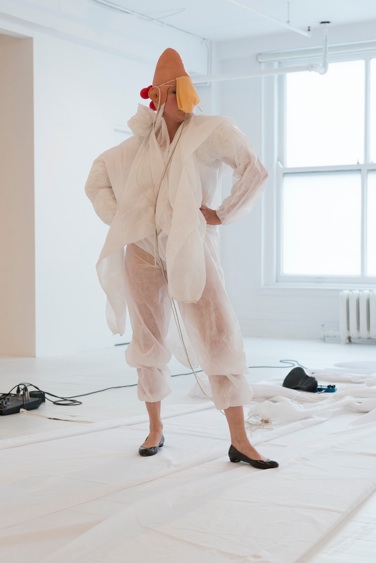Le silence de mon habit comme un cérémonial, une élucidation d’idées claires, en mon pouvoir de femme.
- Belinda CAMPBELL
Le silence de mon habit
comme un cérémonial,
une élucidation d’idées claires,
en mon pouvoir de femme.
Belinda Campbell’s performances appear as situational scenarios with characters that reveal and withhold at the same time. Although the costumes and accessories that define appearances such as the clown’s dress in Le bolero de bonnes boucles! (2012-2014) or the “coverall” in Le décatalogue (2016) project extravagance and extroversion, they also are extremely secretive, occulting something. In a very visual way, they show off. They seem to be a way of diverting our attention while hiding and concealing the performer’s body; in its disappearance, the performer’s body is transformed and protected.
With Le silence de mon habit comme un cérémonial, une élucidation d’idées claires, en mon pouvoir de femme (2016), Campbell again dresses in an “coverall,” but this time it is enhanced by both visible and invisible elements, some even laughable. The figure of the clown is never far away. It is interesting to note that the key signs of this character generally appear via accessories and make-up. These signs also are clichés that relate to the figure of the woman; moreover, at times they suggest a certain power – primarily through lipstick and high heels. Yet here neither make-up nor lipstick is present. No, the red is elsewhere; it is this element, clearly visible in the middle of the face that has the power to say: “this character is not me, and the gestures are not mine…” Sound intervenes then as an extension of the gestures, as an intangible and abstract expression; it is this language that is greater than speech and body movement. The sound is like a light reflecting on the concealing clothes – this light can’t do otherwise.
Nathalie Bachand
Translation and revision by Jennifer Macklem and Janet Logan
Belinda Campbell is a multidisciplinary artist who lives and works in Montreal. Her concerns focus mainly on performance, video performance, music, drawing and poetry. She has presented her work in solo and as part of a group at Axe Neo 7 in Hull-Gatineau, L’oeil de Poisson in Quebec City, Dare-Dare and Optica in Montreal. Her videos have been shown in Marseille at Théâtre Cafoutche and Théâtre de l’Embobineuse, and as part of FIFA (International Festival of Films on Art), curated by Nicole Gingras. In 2004, she became interested in performance art, working solo and as a duo with Caroline Dubois. They formed the Fesses et Crécelle duo (2006-2010) and presented their pieces at Théâtre La Chapelle and at Centre Clark. In 2013, she presented her first performance abroad in Helsinki, Finland. As a pianist, she improvises, and is interested in the manipulation of certain instruments that she uses in composition: some of them being the kalimba, the bandoneon and the korg. Recently she developed La Chambre Kaléidoscopique with artist Pascal Dufaux, a project that combines a video-kinetic machine and musical performance. In 2016, she created a performance in Stéphane Gilot’s art exhibition at Musée d’art de Joliette in which she was concerned with constructing a character through music, using a micro-contact.
Nathalie Bachand is an art writer and curator, who is concerned with the visual and mediated arts. For nearly ten years (2006-2016), she’s been in charge of development for ELEKTRA and the International Digital Art Biennial (BIAN) – for which she notably initiated, created and directed the publication project Angles Digital Arts (2009). In 2012 and 2014, on the invitation of OBORO, she developed, coordinated and presented a series of theoretical workshops on the mediated arts. Actively involved in the cultural milieu, she is currently on the editorial board of ETC MEDIA magazine, and curator for the exhibitions project of the Accès culture network for the 375th anniversary of Montreal that will take place in 2017.


















